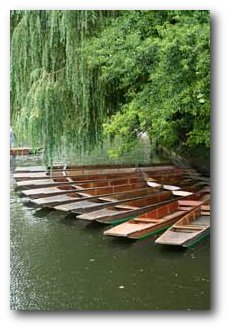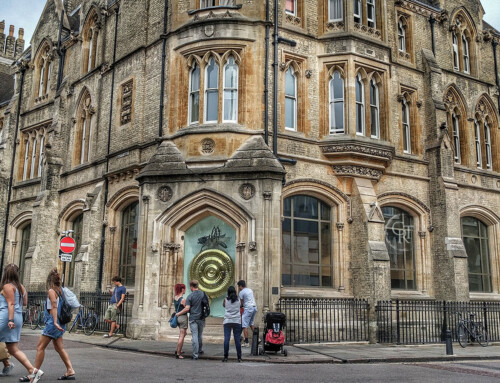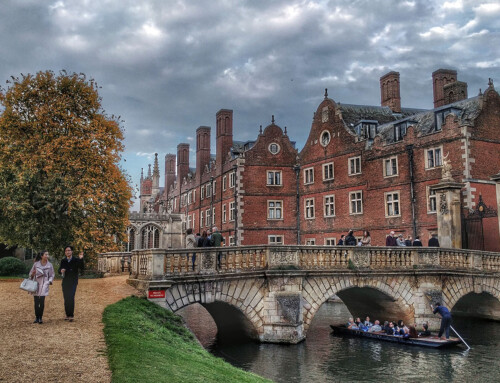
Trinity college punts moored under a tree
If you’ve ever been punting before you’ll have enjoyed one of the many narratives delivered by one of our talented punt chauffeurs. And if you’ve been punting more than once, you may have enjoyed an altogether different narrative, because such is the way with storytelling.
History is a supple and fluid mistress, and in the hands of our chauffeurs she ebbs and flows with the tides of the Cam… (ok, technically the part of the river Cam we punt on isn’t tidal any more but go with it).
With this in mind, we thought it pertinent to bring you the definitive history of punting. Don’t worry though, no spoilers here, we’ll save the best river folklore for on board the punts…
What is punting?
A punt boat, more commonly known simply as a punt, is a square-ended boat that has a flat bottom with no keel.
The normal method of propulsion is by using a 5m (16ft) long pole and literally pushing against the river bed. The pole is also used to steer, either as a tiller or rudder for gentle changes of direction, or by pushing off at an angle to the punt for more advanced manoeuvring. This method of propulsion is known as “punting”.
History of punting
Punts were developed in medieval times to provide stable craft that could be used in areas of water too shallow for rowing conventional craft. One such area was the Fens, the marshy flatlands north of Cambridge, where punts were integral to local trades such as eel fishing, reed-cutting, fowling (hunting ducks, etc) and for transporting cargo, until their use died out in the late nineteenth century.
The first punts are traditionally associated with the River Thames in England and were built as small cargo boats or platforms for fishermen. Pleasure punts – specifically built for recreation – became popular on the Thames between 1860 and 1880.
Since a punt has no keel, it draws only a few inches even when fully laden; this makes it very manoeuvrable and suitable for shallow water.
A punt can be punted equally successfully in either direction; this comes in handy in narrow streams where turning around may be difficult or even impossible.
The square-cut bow gives greater carrying capacity for a given length than a boat of the same beam (boat speak for width) with a narrow or pointed bow; it also makes the boat very stable, and suitable for passengers.
Punting around the UK
In the UK you can hire punts in a number of locations –
- Cambridge
- Oxford
- Stratford
- Canterbury
to name a few. We’ve heard rumours of punts being available for hire in Bath, as well as unsuccessful attempts to introduce punting in Norwich.
There may be other locations that we aren’t aware of (if you know of any then please do let us know). Outside of the UK, Christchurch in New Zealand is notable for having punts available, primarily for guided tours.
Other areas around the world use similar types of boat & propulsion combinations – like the mokoro canoes in the Okavango Delta in Botswana, for example.
The origins of Punting in Cambridge
Punts were introduced to Cambridge as pleasure craft at the start of the 20th century (c.1900). As commercial river traffic died out punting on the Cam became safer and more popular.
Today, pleasure punting is an extremely popular pastime in Cambridge throughout the year, with only the most extreme weather conditions dampening the spirits and putting people off.
The resultant traffic sometimes causes congestion at the height of the season, offering the spectacle of the occasional collision or impromptu dip in the river for the unfortunate punter (as I know from past experience!) .
With so many first timers attempting to get to grips with the technique, whilst trying not to fall in the river, it can provide a source of much amusement, as the video below (shot whilst standing on Garrett Hostel bridge) gives just a small taste of:
Punting in the Present
Punts today are usually 6 to 7 metres long and 1 to 2 metres wide. Smaller punts are limited to 5 passengers and the larger to 12, although in the past punts with up to 20 passengers were often seen – these were exceptionally difficult to manoeuvre.
Before the proliferation of the larger 12 seat (ferry punts), small punts were often chained together side by side, in pairs or sometimes even triples in order to carry more passengers on tours. However, these were not very health and safety friendly, with quite a high risk of trapped fingers for anyone holding onto the side of one of the punts.
There is an apocryphal bit of river folklore that states that the maximum number of passengers in a punt is 12 due to coast guard rules on life rafts. However, UK inland waterways are not covered by HM Coast guard, so this is highly unlikely to be true.
Since adding the above sentence to this post, we have been reliably informed that:
“The river Cam is included in the MCA’s (Maritime and Coastguard Agency) Categorisation of Waters (Category A: Narrow Rivers and canals where the depth of water is generally less than 1.5 metres), and hence their potential jurisdiction notwithstanding the local navigation authority (the Cam Conservancy), hence the need to impose a limit of 12 passengers per punt. Boats holding more than 12 passengers are classified as Passenger Ships and these are covered by various Merchant Shipping Notices which have to be complied with. No punt can do so.”
Whilst the rules of UK waterways dictate that you should travel on the right hand side at all times, experienced punt chauffeurs know that along the river Cam the best route to take is up the middle of the river.
To this day there are still the remnants of a stone causeway that was placed there by the Conservators of the river Cam to allow horses drawing barges to wade up the middle of the river and avoid paying tolls to the Cambridge colleges for crossing their land. The stone bed makes punting much easier and reduces the chances of the pole getting stuck in the silt.
Cambridge Punt Touts
The recent history of punting in Cambridge is often more associated with touting and so called ‘punt wars’. Over the last two decades the number of punt touts has increased dramatically and they have spread throughout the medieval city centre. Few visitors to the historic centre of Cambridge, especially during the summer months, can have failed to notice their presence.

Touts operating on Quayside approx 2008
With one operator occupying all of the prime mooring locations on the river, other operators have no choice but to tout in order to bring in business. Sadly, whilst most touts are well behaved, polite and courteous some are aggressive, rude, pushy and belligerent. Generally touts engaged in this kind of behaviour are new and inexperienced. However, with many operators competing against each other, this can foster and encourage this kind of anti-social behaviour.
We believe that touting is something of a lost art in the UK and should be preserved but with proper and strict regulation. A good tout leaves tourists and locals smiling, is both helpful and polite, as well as being able to provide a wealth of local knowledge and information.
It may be of interest to note that Cambridge has a bye-law in place that bans touting in a manner that could cause obstruction or annoyance. Only one prosecution has ever been brought, for obstruction. If you are touted in a way that you find unpleasant you should get the name of the person concerned and make a complaint to their employer or to the Cambridge City Council.
Public Spaces Protection Order
More recently, in 2016, Cambridge City Council introduced a PSPO (Public Spaces Protection Order) to prohibit punt touting, except within a short distance of authorised punt stations. This is yet another attempt to restrict or limit the proliferation of punt touts operating, primarily on King’s Parade. However, with a maximum fine of £75 it appears to have done little to prevent these unlicensed operators from continuing to ply their trade.
The Future
Today’s future is tomorrow’s past, or something like that. As to what the future of punting in Cambridge (and the rest of the world) holds, if we could predict that then we’d be off down the bookies (oops, wrong kind of punting!). The popularity of punting as a leisure activity doesn’t seem to wane and whilst it’s arguably a bit trickier than navigating a pedallo, or a rowing boat, that doesn’t appear to put people off. Perhaps more rivers and waterways in the UK will see the arrival of punts?
Go punting
If reading all of that has made you keen to experience punting at first hand then why not join us on a punt tour? Click here to find out more about booking your tickets now.







Leave A Comment